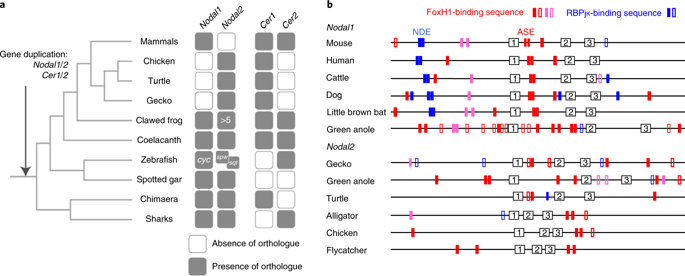Nature Ecology & Evolution ( IF 13.9 ) Pub Date : 2020-01-06 , DOI: 10.1038/s41559-019-1072-2 Eriko Kajikawa 1 , Uzuki Horo 1, 2, 3 , Takahiro Ide 1 , Katsutoshi Mizuno 1 , Katsura Minegishi 1 , Yuichiro Hara 4, 5 , Yayoi Ikawa 1 , Hiromi Nishimura 1 , Masanori Uchikawa 6 , Hiroshi Kiyonari 7 , Shigehiro Kuraku 4 , Hiroshi Hamada 1

|
Unidirectional fluid flow generated by motile cilia at the left–right organizer (LRO) breaks left–right (L–R) symmetry during early embryogenesis in mouse, frog and zebrafish. The chick embryo, however, does not require motile cilia for L–R symmetry breaking. The diversity of mechanisms for L–R symmetry breaking among vertebrates and the trigger for such symmetry breaking in non-mammalian amniotes have remained unknown. Here we examined how L–R asymmetry is established in two reptiles, Madagascar ground gecko and Chinese softshell turtle. Both of these reptiles appear to lack motile cilia at the LRO. The expression of the Nodal gene at the LRO in the reptilian embryos was found to be asymmetric, in contrast to that in vertebrates such as mouse that are dependent on cilia for L–R patterning. Two paralogues of the Nodal gene derived from an ancient gene duplication are retained and expressed differentially in cilia-dependent and cilia-independent vertebrates. The expression of these two Nodal paralogues is similarly controlled in the lateral plate mesoderm but regulated differently at the LRO. Our in-depth analysis of reptilian embryos thus suggests that mammals and non-mammalian amniotes deploy distinct strategies dependent on different Nodal paralogues for rendering Nodal activity asymmetric at the LRO.
中文翻译:

节点旁系物是爬行动物和哺乳动物内脏左右不对称的不同机制的基础
在小鼠、青蛙和斑马鱼的早期胚胎发生过程中,左右组织器 (LRO) 处的活动纤毛产生的单向流体流动打破了左右 (L-R) 对称性。然而,鸡胚不需要运动纤毛来破坏 L-R 对称性。脊椎动物之间 L-R 对称性破坏机制的多样性以及非哺乳动物羊膜动物中这种对称性破坏的触发因素仍然未知。在这里,我们研究了如何在马达加斯加地壁虎和中华鳖这两种爬行动物中建立 L-R 不对称性。这两种爬行动物在 LRO 似乎都缺乏活动纤毛。节点的表达发现爬行动物胚胎中 LRO 的基因是不对称的,这与依赖纤毛进行 L-R 模式的脊椎动物(如小鼠)相反。源自古代基因重复的节点基因的两个旁系同源物在纤毛依赖和纤毛非依赖的脊椎动物中被保留和差异表达。这两个Nodal paralogues 的表达在侧板中胚层中同样受到控制,但在 LRO 中的调节不同。因此,我们对爬行动物胚胎的深入分析表明,哺乳动物和非哺乳动物羊膜动物根据不同的节点旁系同源物部署不同的策略,以使 LRO 的节点活动不对称。











































 京公网安备 11010802027423号
京公网安备 11010802027423号